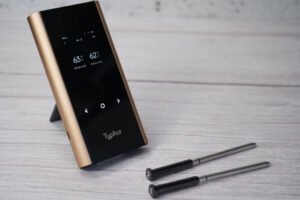How to Choose a Perfect Meat Thermometer

Cooking meat perfectly every time is an art that’s grounded in science, and the secret behind that success often comes down to one simple tool: a meat thermometer. Whether you’re preparing a holiday roast, weeknight chicken breast, or a thick-cut steak on the grill, knowing the exact internal temperature is the difference between juicy and dry—or safe and undercooked. In recent years, the wireless meat thermometer has taken center stage, offering convenience, accuracy, and real-time feedback that make the cooking process easier and more reliable than ever.
If you’re in the market for a meat thermometer but aren’t sure what to look for, you’re not alone. From traditional dial thermometers to advanced wireless options, the range can feel overwhelming.
Why You Need a Meat Thermometer
Let’s start with the basics: why bother with a meat thermometer at all? The answer is simple—precision.
Visual cues and timing can vary significantly depending on the size, shape, and cut of meat. You might think your pork chop is cooked because it looks browned on the outside, but it could be raw inside. Or you might overcook that expensive prime rib because you’re relying on a general time estimate.
A meat thermometer ensures food safety (especially with poultry and ground meats) while helping you hit the sweet spot of doneness—whether that’s rare, medium, or well-done. It also helps avoid food waste from overcooking, which can dry out meat and make it less enjoyable to eat.
Types of Meat Thermometers
Before you choose, it’s helpful to know the main categories available.
1. Dial (Analog) Thermometers
These are the old-school models you often see in kitchens. They’re budget-friendly and don’t require batteries, but they can be slower and less precise. Not ideal for grilling or fast cooking.
2. Digital Instant-Read Thermometers

Instant read meat thermometers offer quick readings, usually within 3 to 10 seconds. You insert the probe into the thickest part of the meat and get an accurate temperature instantly. They’re great for spot-checking during cooking.
3. Leave-In Probe Thermometers
These thermometers are designed to stay in the meat while it cooks. A probe is inserted and connected to a display outside the oven or grill. They’re ideal for roasts, whole chickens, or anything that takes time to cook.
4. Wireless Meat Thermometers

The latest evolution in meat thermometer technology, a wireless meat thermometer lets you monitor cooking temperatures remotely via an app. This is perfect for multitasking, outdoor grilling, or low-and-slow smoking sessions. Many wireless models offer dual or multiple probes, temperature alerts, and preset cooking options based on meat type and doneness.
Key Features to Consider
Choosing the perfect thermometer isn’t just about the type—it’s also about the features that match your cooking style.
1. Accuracy
The whole point of a thermometer is precision. Look for models with a margin of error of ±1 to 2 degrees Fahrenheit. Calibration options are a plus if you want to fine-tune accuracy over time.
2. Speed
Quick response time is essential, especially when grilling or searing where every second counts. Instant-read models should give results in under 5 seconds.
3. Temperature Range
Make sure the thermometer covers a wide temperature range—at least up to 500°F. This ensures versatility whether you’re baking, roasting, grilling, or smoking.
4. Connectivity and App Control
With a wireless meat thermometer, app functionality is key. Look for intuitive apps that let you monitor real-time temperature, set custom alerts, and access doneness presets. Some even provide visual graphs of your cooking progress.
5. Number of Probes
If you often cook multiple types of meat at once, or want to monitor different sections of a large roast, choose a model with two or more probes.
6. Durability and Design
Heat-resistant stainless steel probes are a must. Also consider splash resistance and build quality—especially if you’ll be using the thermometer outdoors.
7. Battery Life
Wireless thermometers typically run on rechargeable batteries. Look for a long battery life, especially for slow-cooked meals or overnight smokes.
Practical Tips for Using Your Thermometer
- Insert the probe into the thickest part of the meat, avoiding bones and fatty areas which can skew readings.
- Always clean the probe after each use to prevent cross-contamination.
- For large cuts like brisket or turkey, test in more than one location to ensure even doneness.
- Let the meat rest after cooking to allow juices to redistribute—your thermometer helps you know when to pull it at just the right moment before resting.
When to Use a Meat Thermometer
A meat thermometer is useful far beyond special occasions. Here are everyday situations where it can elevate your cooking:
- Grilling steaks to precise doneness
- Roasting chicken or turkey
- Baking meatloaf or casseroles
- Smoking pork shoulder or brisket
- Sous vide cooking followed by a quick sear
Basically, any time you want food to be both safe and delicious, a thermometer should be part of the process.
Final Thoughts
A meat thermometer might seem like a simple tool, but it plays a critical role in turning a good cook into a great one. With the rise of smart technology, choosing a wireless meat thermometer adds both convenience and control to your culinary arsenal. Whether you’re a seasoned home chef or just learning your way around the kitchen, having the right thermometer can take the stress out of cooking and bring consistency to every meal.
So when you’re ready to make your next meat-centered dish, don’t leave doneness to chance. Let technology do the heavy lifting—and enjoy perfectly cooked results, every single time.





